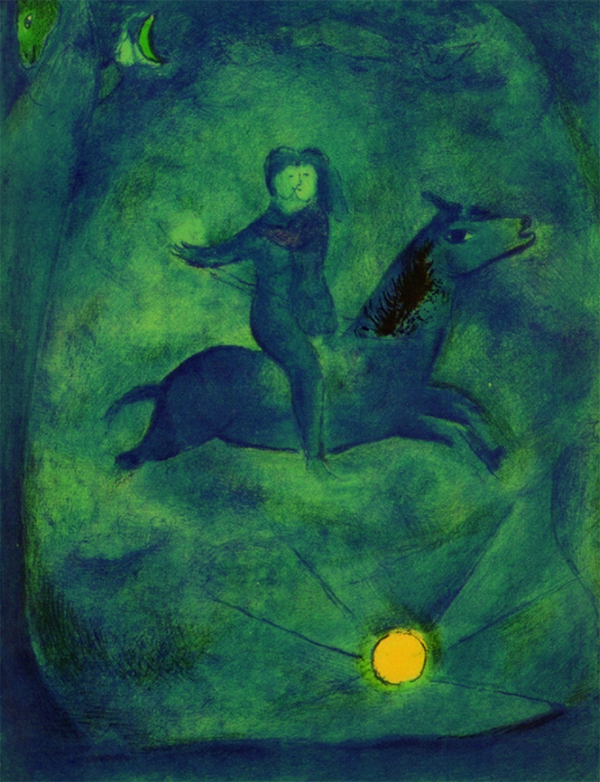
DOI:
https://doi.org/10.14483/21450706.19621Published:
2022-07-22Issue:
Vol. 17 No. 32 (2022): Julio-Diciembre 2022Section:
Sección CentralEstudio comparativo sobre los aspectos estéticos y de construcción de las ilustraciones de Sani ol-Molk y Chagall, adaptados de las historias de Las mil y una noches
A comparative study on the aesthetic and constructive aspects of the illustrations by Sani ol-Molk and Chagall, adapted from One Thousand Nights stories
Estudo comparativo sobre os aspectos estéticos e construtivos das ilustrações de Sani ol-Molk e Chagall, adaptadas dos Contos de " One Thousand and One Nights "
Keywords:
Chagall, ilustración, One Thousand and One Nights, oriental elements, Sani ol-Molk (es).Keywords:
Chagall, illustration, One Thousand and One Nights, oriental elements, Sani ol-Molk (en).Keywords:
Chagall, ilustração, As mil e uma noites, elementos orientais, Sani ol-Molk (pt).References
Afshar Asl, Mehdi, Khosravi, and Mohammad Baqer (1998). Iranian architecture in the Qajar period. Journal of Art and Architecture, 36, 129-140.
Bachelard, G. (2006). External and internal dialectics, phenomenology of imagination (Trans.: Amir Maziar). Tehran, Iran: Academy of Arts Publications.
Barr, A. H. (Ed.) (1986). Defining modern art: Selected writings of Alfred H. Barr. New York, NY, USA: Harry N. Abrams Inc.
Blair, M. (2020). The Art of the 1,001 Nights. https://blairmahoney.medium.com/the-art-of-the-1-001-nights-58d4476c3bfa
Bouzari, A. (2004). One Thousand and One Nights: Of the bridge between East and West. Journal of Culture and People, 11-12, 50-60.
Farzi Dehneh Sari, E. (2009). Research on reality and imagination in the works of Mark Chagall [Master’s thesis, University of Tehran].
Gharabaghi, A. A. (2000). Blue cows and red lovers. Golestaneh Magazine, 24, 47-60.
Hoh, A. (2017). A Thousand and One Nights: Arabian story-telling in world literature. https://blogs.loc.gov/international-collections/2017/10/a-thousand-and-one-nights-arabian-story-telling-in-world-literature/
Mazolov, U. (2004). Iranian prototype of Hazaryik Shab-Hezar Afsan. Journal of Culture and People, 11-12, 6-14.
Nobis, N. (1999). Marc Chagall: Arabian Nights. Munich, Germany: Prestel.
Pakbaz, R. (2007). Iranian painting from long ago to today. Tehran, Iran: Zarrin and Simin Publishing.
Pakbaz, R. (2010). Encyclopedia of art (11th ed.). Tehran, Iran: Contemporary Culture.
Sojoodi, F., and Gilani, S. (2011). Visual signs of a Thousand and One Nights, a comparative study of illustrations by Sani ol-Molk and Mark Chagall. Journal of Visual Arts, 2, 42-55.
Zabolinezhad, H., Pencenat, C., and Shad Qazvini, P. (2020). A new ontology study in contemporary art. Journal of Critical Reviews, 9(7), 480-486. https://www.coursehero.com/file/81565290/197-1591270499pdf/
Zarezadeh, F., and Shad Qazvini, P. (2008). A study of realistic codes in the manuscript of Hezarovik Shab. Islamic Art Studies, 9, 50-62.
Zoka, Y. (2003). Life and works of Ostad Sani ol-Molk. Tehran, Iran: University Publishing Center of the Cultural Heritage Organization.
How to Cite
APA
ACM
ACS
ABNT
Chicago
Harvard
IEEE
MLA
Turabian
Vancouver
Download Citation
Estudio comparativo sobre los aspectos estéticos y de construcción de las ilustraciones de Sani ol-Molk y Chagall, adaptados de las historias de Las mil y una noches
A Comparative study on the aesthetic and Constructive Aspects of the Illustrations of Sani ol-Molk and Chagall, Adapted from One Thousand and One Nights Stories
Etude comparative sur les aspects esthétiques et constructifs des illustrations de Sani ol-Molk et Chagall, adaptées des contes de « Les Milles et Une nuits »
Estudo comparativo sobre os aspectos estéticos e construtivos das ilustrações de Sani ol-Molk e Chagall, adaptadas dos Contos de " One Thousand and One Nights "
Estudio comparativo sobre los aspectos estéticos y de construcción de las ilustraciones de Sani ol-Molk y Chagall, adaptados de las historias de Las mil y una noches
Calle14: revista de investigación en el campo del arte, vol. 17, núm. 32, pp. 254-273, 2022
Universidad Distrital Francisco José de Caldas

Esta obra está bajo una Licencia Creative Commons Atribución-NoComercial-CompartirIgual 4.0 Internacional.
Recepción: 24 Octubre 2021
Aprobación: 30 Enero 2022
Resumen: Este artículo estudió los cuadros de Sani ol-Molk, un artista Qajar iraní, y los de Chagall, un artista ruso-judío, y tiene por objetivo responder la pregunta por qué elementos y técnicas utilizaron los artistas para ilustrar historias de Las mil y una noches de tal modo que la forma sirviera apropiadamente al contenido. Los dos pintores, Sani ol-Molk y Chagall, con puntos de vista particulares, influenciados por discrepancias socioculturales de Oriente y Occidente respectivamente, crearon cuadros para las historias utilizando sus propios estilos artísticos. Este artículo comparó pares de ilustraciones de Sani ol-Molk y Chagall que tienen el mismo tema pero son completamente distintos tanto estructural como estéticamente. También analizó las obras en cuanto a la forma, la composición, el color, los elementos visuales y los símbolos. Los pares se dividen entre tres categorías de acuerdo con su tema, lo cual incluye romances, imaginarios, y la vida cotidiana. A pesar de las diferencias considerables entre las obras de los dos pintores, tanto Sani ol-Molk (combinando técnicas naturalísticas y estilos de pintura Qajar) y Chagall (utilizando libremente la cultura visual, los colores y las formas de la cultura visual occidental y mezclándolos con elementos iraníes, indios y árabes, así como con iluminación oriental) ilustraron Las mil y una noches de manera exitosa y lograron crear una fantasía.
Palabras clave: Chagall, ilustración, Las mil y una noches, elementos orientales, Sani ol-Molk.
Abstract: This paper studied the paintings of Sani ol-Molk, a Qajar Iranian artist, as well as those of Chagall, a Russian-Jewish artist, and it aims to answer the question of what elements and techniques were employed by the artists to illustrate One Thousand and One Nights stories in such a way that the form appropriately serves the content. The two painters, Sani ol-Molk and Chagall, with distinct viewpoints, influenced by Eastern and Western socio-cultural discrepancies, respectively, created paintings for the stories using their own artistic styles. This paper compared pairs of Sani ol-Molk and Chagall’s illustrations that have the same theme but are completely different both structurally and aesthetically. It also analyzed the works in terms of form, composition, color, visual elements, and symbols. The pairs are divided into three categories in terms of their subject, including romances, imaginaries, and everyday life. Despite the considerable differences between the works of the two painters, both Sani ol-Molk (by combining naturalistic techniques and Qajar painting styles) and Chagall (by freely using Western visual culture, colors, and forms and mixing them with Iranian, Indian, and Arabic elements as well as with oriental lighting) illustrated One Thousand and One Nights successfully and achieved to create a fantasy.
Keywords: Chagall, illustration, One Thousand and One Nights, oriental elements, Sani ol-Molk.
Résumé: Cet article a étudié les peintures de Sani ol-Molk , un artiste Qajar iranien , et ceux de Chagall, un artiste juif russe, et vise à répondre à la question de savoir quels éléments et techniques les artistes ont utilisés pour illustrer les histoires des Mille et une Nuits de telle manière que forme ait servi de manière appropriée le contenu. Les deux peintres, Sani Ol-Molk et Chagall, avec des points de vue particuliers, influencés respectivement par les divergences socioculturelles de l'Est et de l'Ouest, ont créé des cadres pour les histoires en utilisant leurs propres styles artistiques. Cet article a comparé des paires d'illustrations de Sani ol-Molk et Chagall qui ont le même thème mais sont complètement différentes à la fois structurellement et esthétiquement. L’on a également analysé les œuvres en termes de forme, de composition, de couleur, d'éléments visuels et de symboles. Les paires sont divisées en trois catégories selon leur thème, qui comprend les liaisons amoureuses, l'imaginaire et la vie quotidienne. Malgré les différences considérables entre les œuvres des deux peintres, Sani ol-Molk (combinant des techniques naturalistes et des styles de peinture Qajar ) aussi bien que Chagall (utilisant librement les couleurs et les formes de la culture visuelle occidentale et les mélangeant avec des éléments iraniens, indiens et arabes ainsi que l'éclairage oriental) ont illustré Les Mille et Une Nuits avec succès et ont réussi à créer une fantaisie.
Mots clés: Chagall, illustration, Mille et une Nuits, éléments orientaux, Sani ol-Molk.
Resumo: Este artigo estudou os quadros de Sani ol-Molk, um artista Qatar iraniano, e os de Chagall, um artista russo-judio, e tem por objetivo responder à questão de quais elementos e técnicas os artistas utilizaram para ilustrar histórias de As Mil e Uma Noites de tal modo que a forma serviu apropriadamente ao conteúdo. Os dois pintores, Sani ol-Molk e Chagall, com pontos de vista particulares, influenciados por discrepâncias socioculturais no Oriente e no Ocidente, respectivamente, criaram quadros para as histórias utilizando seus próprios estilos artísticos. Este artigo comparou pares de ilustrações de Sani ol-Molk e Chagall que têm o mesmo tema mas são completamente distintos tanto estrutural como esteticamente. Também analisou as obras enquanto a forma, a composição, a cor, os elementos visuais e os símbolos. Os pares se dividem entre três categorias de acordo com o seu tema, o qual inclui romances, imaginários e a vida cotidiana. Apesar das diferenças consideráveis entre as obras dos dois pintores, tanto Sani ol-Molk (combinando técnicas naturalistas e estilos de pintura Qatar) e Chagall (utilizando livremente a cultura visual, as cores e as formas da cultura visual ocidental e mesclando-as com elementos iranianos, indianos e árabes, assim como iluminação oriental) ilustraram As Mil e Uma Noites com sucesso e conseguiram criar uma fantasia.
Palavras-chave: Chagall, ilustração, As mil e uma noites, elementos orientais, Sani ol-Molk.
Introduction
One Thousand and One Nights has been always interesting for artists from various fields of art, and many composers, moviemakers, painters, architects, and writers have chosen it as a rich source of inspiration for their works. The main story is about a Sasanian monarch (Shahryar), an it is narrated by his Minister's daughter (Shahrazad). The story goes that, when Shahryar discovered that his queen was unfaithful, he decided to take revenge. He first killed the queen and then took a new bride each night to have her murdered the next morning over a three-year period. Eventually, the Minister, who was responsible for finding the new brides, could not bear the cruelty of the action and asked his wise daughter, Shahrazad, to find a solution. Shahrazad volunteered to marry Shahryar and began telling him a collection of stories, but she would halt her story at a suspenseful moment and tell Shahryar that she would finish it the following night if he let her to live one more night. This happened for 1,001 nights consecutive. On the last night, the king, who had fallen in love with Shahrazad, relinquished murdering her, and they lived together peacefully for the rest of their lives. Most of the adventures of One Thousand and One Nights take place in Baghdad. However, some stories have Iranian origin and were influenced by Indian or Arabic works: As it [was] mentioned before, the tales themselves combine many genres, and draw from the very rich heritage and folkloric tradition of the entire Middle Eastern region. They combine the magical, the mystical, and the mythical, with the real and the historical. Some of the main protagonists in the tales, for example, are the famous Abbasid Caliph Harun al-Rashid and his Grand Vizier Ja’far Barmaki, as well as the famous poet Abu al-Nuwwas, in addition to genies, ghouls, and mythical giant birds such as the Ruk. It is worth noting, however, that due to the folkloric nature of the tales, the Arabian Nights were often considered plebian rather than high literature. Furthermore, because some of the stories contain explicit sexuality and sexual innuendo, as well as bawdy language, and themes not acceptable by polite society, they were also deemed quite vulgar. (Hoh, 2017)
No one knows the exact age of the stories. Although the collection of stories is read and understood by the cultures that have affected it for centuries, it should be noted that it does not communicate concepts such as originality, style, or individual and ethnic identity. Nesting storytelling is the narrative structure of One Thousand and One Nights, as often more than two nested stories are narrated in parallel. The book One Thousand and One Nights, by Sania ol-Molk, is one of the most detailed illustrations adapted from a literary work. In his illustrations, Sania ol-Molk depicted various aspects of the everyday and private life of ordinary people who lived in the Qajar period (1789-1925) in Iran, as shown in scenes such as bathing, cooking, eating, horseback riding, dancing, sleeping, etc. Furthermore, the painter has not refrained from illustrating the scenes that were not considered to be worthy of displaying until then. He explicitly depicted social behaviors such as violence and reconciliation, fighting, kicking, conspiracy, and so on. Therefore, in his works, there are variety of body gestures according to the themes of the stories: that is why we subscribe entirely to the point of view of Ernest Gombrich and Nelson Good Man concerning a pictorial representation which would move towards the establishment of a conception on the perception of images. This conception follows conventions internalized by the person who perceives them, conventions that differ from each other and each one of us establishes them according to our own way of life, so we can link the exercise of Segall, Campbell, and Herskowitz with Gombrich and GoodMan's hypothesis concerning the conventional codes governing the perception of images. (Zabolinezhad, Pencenat, and Shad Qazvini, 2020, p. 942) During the eighth century, many Persian stories were translated into Arabic. According to professor Ulrich Marzolph (1953), “there are striking similarities between One Thousand and One Nights tales and the Torah stories, especially in the book of Esther” (Marzolph, 2004, p. 8).
Perhaps this was the main reason for Chagall to take up illustrating One Thousand and One Nights stories, as he had previously illustrated 63 pages of the Bible. His style with regard to painting characters in his works was in accordance with the mystical teachings of Russian Judaism, which were interpreted with the painter's mystical viewpoint. He is among a few artists who used Eastern elements to successfully translate the stories into images, so that they were understandable to Western people. Some questions arise here: How was a combination of Eastern elements and Western naturalistic techniques able to create fantasy in the works of Sani ol-Molk and Chagall? How does the painters' illustrations reflect the narrative features of the stories? Can a common ground between the exorbitant dissimilarities of the painters' works be found? This study aims to determine the artistic features and different aspects of Sani ol-Molk and Chagall's works which were adopted for stories with the same theme. It also attempts to provide a comparative analysis based on the structural differentiations between the illustrations of the above-mentioned painters.
Library research
There are studies that compare the illustrated works of Sani ol-Molkand and Chagall from One Thousand and One Nights, such as Visual Semiotics of One Thousand and One Nights. A Comparative Study of Illustrated Works of Sani ol-Molk and Marc Chagall by Farzan Sojoodi and Saedeh Gilani (2011). The paper studies how the works of said authors were influenced by their geography, culture, and society, and it concludes that culture and art represent social realities. Fahimeh Zarezadeh and Parisa Shad Qazvini (2008), in another paper titled The Analysis of Realistic Codes in The Manuscript of One Thousand and One Nights, state a number of facts about the relationship between human beings and the environment and then conclude that Sani ol-Molk has reflected his cultural values and believes in his illustrations. None of the aforementioned papers performs a comparative aesthetic analysis of the illustrations by Sani ol-Molk and Chagall. Elahe Farzi Dahaneh Seri (2009), in her MA thesis titled A Study of Reality and Fantasy in the Works of Marc Chagall attempted to define fantasy, reality, and their connection in Chagall's paintings.
Methodology
This study used a descriptive-analytical-comparative method based on an aesthetic approach, and its information resource of the study consisted of library studies and scientific research articles.
Everyday life
Some tales of One Thousand and One Nights take place on the streets and represent everyday life, and Sani ol-Molk depicted scenes of everyday life in the Qajar period to illustrate them. He was quite skillful in showing the interior spaces and corners of buildings and mansions of the Qajar time (Figure 1). Figure 1 shows parts of Qamar ol-Zaman's father aristocratic house, with walls embellished by colorful murals. The painting shows Gohari, admiring the beauty of Qamar ol-Zaman because she reminds him of his lover. The naturalistic display of the trees behind the window, applying western style and combining it with the interior space using the Iranian painting style has been skillfully performed, in such a way that the differences of the applied styles are hardly noticeable: he has adapted proportions to the principle of nature as much as possible, observed the accuracy of the plan according to those proportions, and made a composition regarding the location and the theme, by incorporating Eastern and western styles in a completely innovative and specific way. (Zoka, 2003, p. 34)
While creating his illustrations, Sani ol-Molk was inspired by the lives of the Iranian people during the 13th century AH. Therefore, his illustrations from One Thousand and One Nights depict the clothing of people in Qajar era. Moreover, from an architectural point of view, in Sani-ol-Molk's illustrations, one can see houses, rooms, niches, walls, sash windows and French-style windows that had just arrived in Iran, paving yards, pools, kitchens, treasury baths, bazaars, and many other architectural features of the Qajar era. (Zoka, 2003, p. 34) These are among the architectural visual documents of Qajar period, and, in contrast to the tradition of Iranian painting, which often shows an architectural structure as a whole, they reflect part of a certain structure, which is chosen based on the logic of narration, regardless of emphasizing on aesthetic quality. In order to display the events that happened in the buildings, Sani ol-Molk often chooses the spaces enclosed between two interior walls called triangular corners.
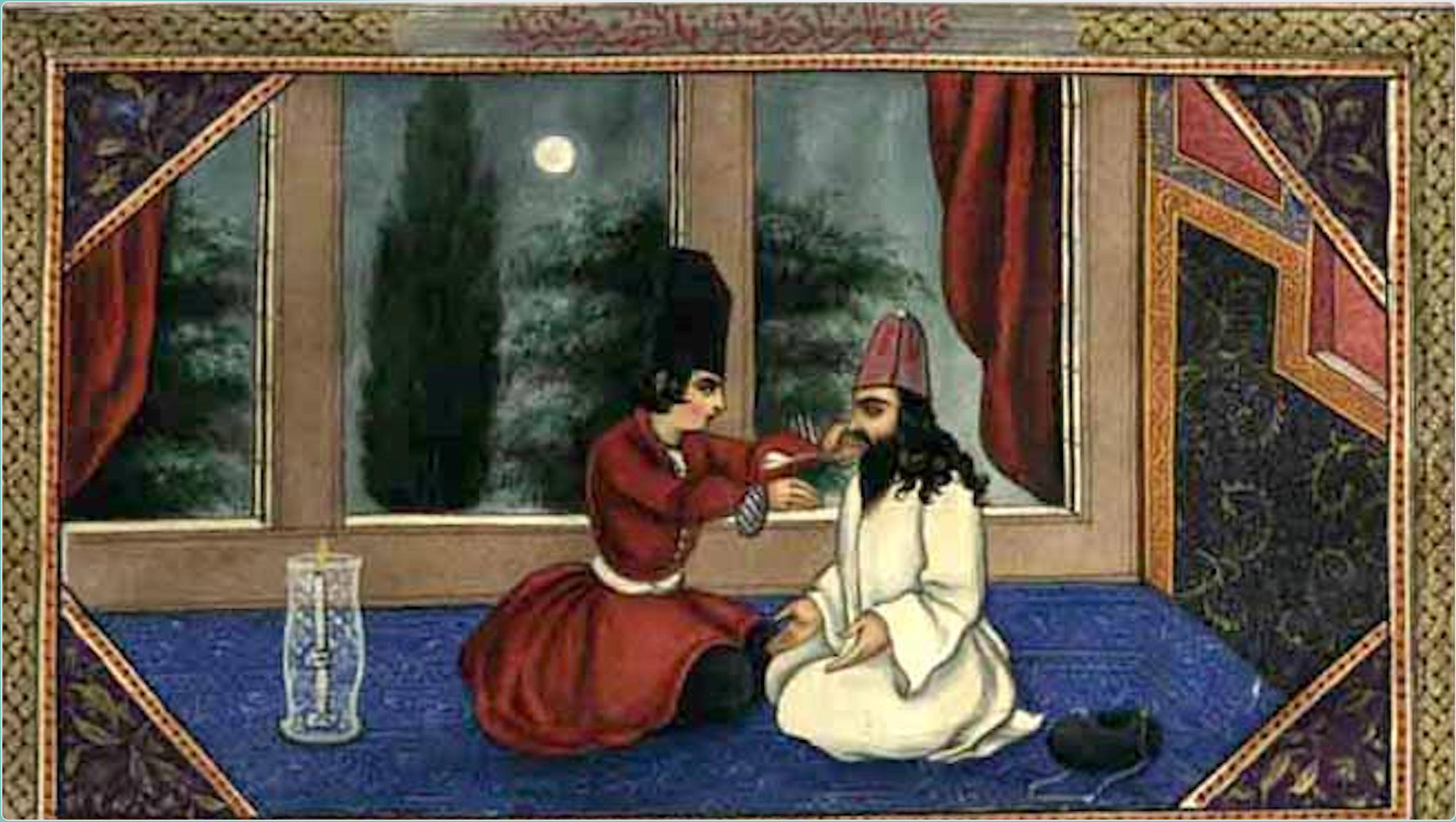
Figure 1. Qamar Al-Zaman and Gohari story (1853), Sani ol-Molk, Golestan Palace Museum. Source: One Thousand and One Nights, illustrated by Sani ol-Molk
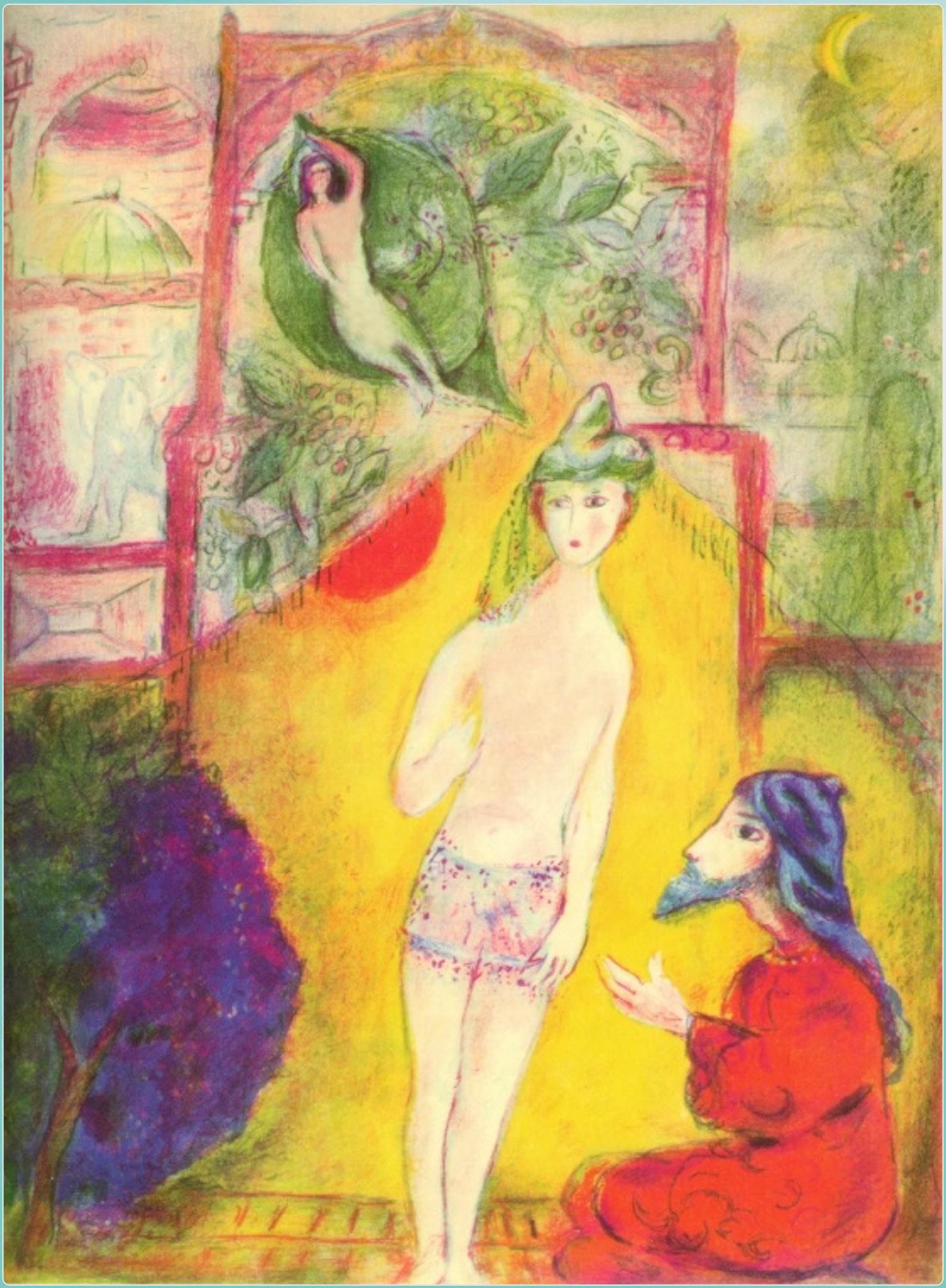
Figure 2. Nine hundred and sixty-fifth night, from One Thousand and One Nights (1948), Chagall. Source: Arabian Nights by Chagall According to Asl, Khosravi, and Baqer,
the architecture of the Qajar dynasty is superior and more complicated than those of former dynasties like Zandieh and Safavid, because diversity and innovation of created spaces increased during the late Qajar era, and old patterns of Iranian architecture evolved in favor of expanding the space. (1998, p. 133)
Therefore, in Sani ol-Molk's paintings, the tendency to open the interior space, to deepen it and turn it into a natural place for living, was influenced by the architectural reforms that took place in Qajar era. Sani ol-Molk achieved a certain narrative style by illustrating different scenes of a story in consecutive frames. Three to six narrative assemblies were illustrated on one page, separated by gilded margins, and the subject of each was written in Riqa calligraphy and in colorful ink on the margin. The narrative aspect of Chagall's works, on the other hand, was characterized by using far and near elements in the same frame on a page. In Figure 2, he depicts subjective and objective spaces together and displays Qamar ol-Zaman and the lover, Darvish, lying on a leaf in the background. Chagall has given Qamar ol-Zaman a female body. In this collection of works, colors and forms are intertwined with the romantic atmosphere of the story, and each section refers to one part of it. In other words, in Chagall's illustrations, time and place disappear, and different scenes are displayed on the same page. Since Chagall emphasizes the psychology of colors in his works, it seems that the red color of Darvish's clothes signifies his great love for Qamar ol-Zaman: “colors in Chagall's works are fluid and free and serve as symbols in his works” (Farzi Dahaneh Seri, 2009, p. 111). Simultaneously displaying the moon and the sun in this work, the yellow and red colors of the background and foreground, the turban on the head of the Qamar standing naked, and a yellow triangular form with fringe, which seems like a desert tent, all arise feeling of hot summer days and oriental features. According to Blair (2020). “in the early 20th century, artists experimented with color and less realistic dimensions, and mixed the worlds of Eastern and Western mythologies.” An interesting point about the elements of the composition is the use of obscured Islamic monuments on both sides of the image. Chagall, by mixing Eastern elements with Western visual culture (the naked woman), has taken the initiative and managed to easily attract the minds of Western audiences; “Chagall, with his dreamy outlook, has given his paintings symbolic meanings by employing religious symbols” (Sojoodi and Gilani, 2011, p. 46).
In another illustration of One Thousand and One Nights by Sani ol-Molk, a woman strolls leisurely along with her servant girls and companions along the streets of Basra on a Friday morning. This panting (Figure 3) shows the horizontal composition of female characters, standing in a harmonious way in full face, half face, and tree-quarter face views, as well as wearing Qajar customs. Qamar ol-Zaman and Gohari are among the stories in which women play a pivotal role. In cultural studies about women, One Thousand and One Nights has been a relatively important reference because it contains dozens of female characters who have various major functional and moral roles:
the book seems to be the result of public opinion and different experiences of its authors […] and has provided the opportunity of expressing an idea, or the way it should be dealt with, and finally, has determined the eternity or mortality of the idea. (Zarezadeh and Shad Qazvini, 2008, p. 55)
In One Thousand and One Nights,Shahrazad describes the women of the stories as persons who are wise, brave, and valiant, professional lovers as well as artists. Consequently, women are not looked down upon by others or made less than what they are. Sani ol-Molk, in line with the narrator of the stories, has provided a neutral image of the women in his works, indicating that he was profoundly influenced by the character of Shahrazad and the other women in the stories.
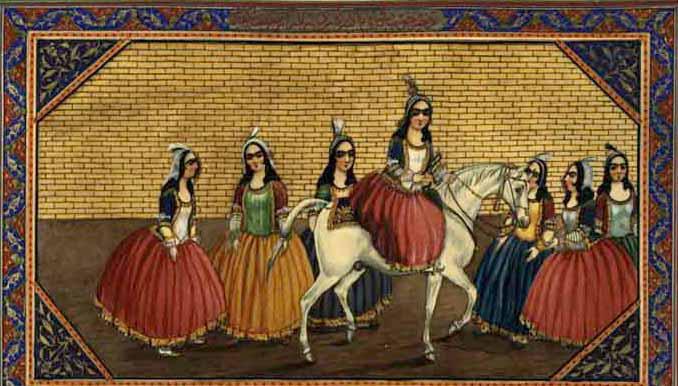
Figure 3. Qamar ol-Zaman and Gohari story (1853), One Thousand and One Nights, Golestan Palace Museum. Source: One Thousand and One Nights, illustrated by Sani ol-Molk
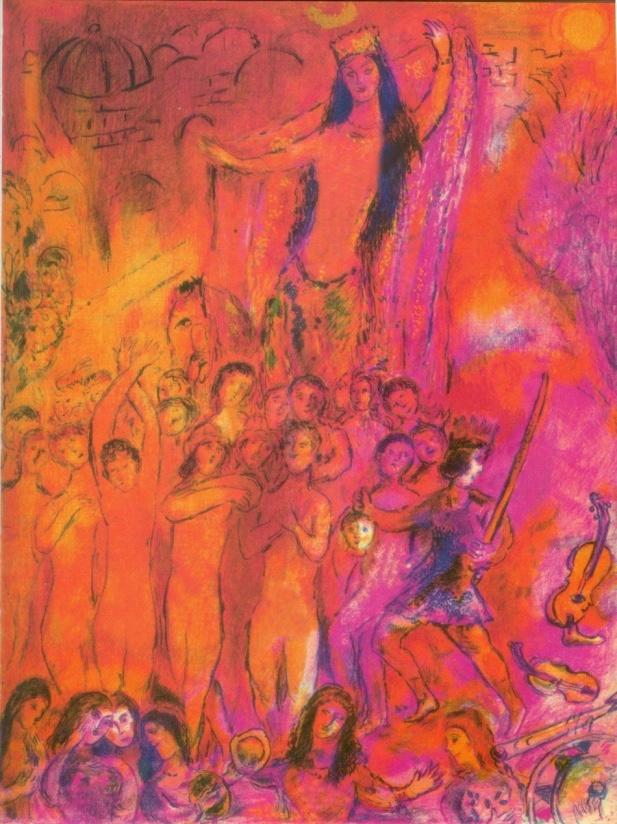
Figure 4. Nine hundred sixty-sixth night, One Thousand and One Nights (1948), Chagall. Source: Arabian Nights by Chagall
In Sani Al-Molk‘s paintings, women's costumes and their hair, faces, bodies, and makeups are very similar. They have been painted with linked eyebrows, small mouths, and red cheekbones, while a scarf covers half of their black hair. The psychological characteristics and positive and negative personalities of women have been not reflected in their appearances. Accordingly, women's faces are not distinguishable from each other. As it is common in his previous works, red has been used for women’s skirts and upper garments. The background is a simple brick-made texture that does not inspire any dimension or depth to the audience. In contrast to this relatively simple and horizontal composition of Sani ol-Molk, in the composition of Chagall’s work for the same theme, we can see a vertical image with groups of men and women. In Figure 4, red, orange, and purple in the background fit the theme of the story, and oriental architecture is seen in the background of the dancer while the hot and scorching sun, together with warm colors, creates the atmosphere of the painting. Chagall, by adding hot desert colors and Arabic visual elements to the main character of the illustration, who is holding a cloth, has given the story an Arabic identity to some extent. In this scene, Qamar ol-Zaman and her companions stroll leisurely in the alley and bazaar while men are not allowed to enter the alleys until they leave the place. In fact, there is no man in this part of the story. According to Zabolinezhad et al.,
these pictorial representation codes are known to Iranian and even oriental audience. Because these conventional codes are still in force in their traditions of pictorial perception. However, it is quite different for westerners who are not familiar with these codes, and who have no idea how they should receive and interpret these enigmatic scenes. (2020, p. 943)
Chagall, however, has added or omitted a part or some parts to the main image according to his own subjective view and disregarded the main elements of the story. Furthermore, he has depicted the main character as if he were larger than the others, and, unconsciously, he has taken advantage of perspectives on authority in his work. The moon and the sun are constant symbolic elements in Chagall’s works. At the bottom of the frame, Qamar ol-Zaman enters the image from the right while holding a stick in her hand and runs to the left of the frame, inspiring energy and mobility, which are prominent features of Chagall's paintings (Figure 4).
According to Barr, “Russian Jews seem to have had a vibrant and unique culture” (1986, p. 125). It can be said that Chagall's childhood experiences and religious teachings play a major role in his works, which he represents by applying bright and energetic colors. Vertical composition, mobility and dynamicity, warm and energetic colors, the use of oriental and pictorial elements, and the lack of fidelity to the main atmosphere of the story are dominant features of his illustrations, in contrast to the realistic paintings of Sani ol-Molk.
Imaginaries
There are many fairy tales and mythical creatures in One Thousand and One Nights, which provides a good basis for the artists to show their art. In a scene of the ebony horse story with an imaginative theme, Sani ol-Molk has used the main features of Iranian painting to illustrate the fiction. In this painting (Figure 5), the prince kidnaps the daughter of the king of Sanaa and rides to her father's palace. Adding figures on the left and displaying the horse along with two riders on the top right of the frame perfectly creates an Iranian atmosphere. A kind of depth is inspired by displaying pale mountains at the farthest point, and sometimes by drawing minimized trees, buildings, or some other elements in the depth of the image. We can see azure red and blue used in the clothes and pants of the figures. Sani ol-Molk's creativity in combining real and imaginary spaces demonstrates his perfect visual literacy. In fact, Sani ol-Molk's trip to Europe, where he concentrated on real life and taking ordinary people and events as models, significantly influenced his illustrations of of One Thousand and One Nights stories. He portrays people he sees in the Nasserite court (1831-1896), in alleys, and among friends and acquaintances. If he presents a picture of a castle, it is undisputedly an image of a king's palace, and, if he displays a street, he depicts an alley of Tehran in the Nasserite time. According to Barr (1986, p. 120): “the characters of One Thousand and One Nights stories are the people of thirteenth-century Iran, and the stories take place in the Nasserite era”. It can be said that the visual features of Sani ol-Molk's works were considerably influenced by the social atmosphere of his time. Sojoodi and Gilani (2011) state that “one of the most important results obtained from the study of Sani ol-Molk's illustrations is his cultural interpretation, which means that his visual perception of the verbal text was in accordance with the culture of his time” (p. 45). Chagall has created the same scene by applying limited colors in an imaginative atmosphere. Surprisingly, in Figure 6, the horse's head is on the top left corner of the frame and the moon and sun are seen on the top and bottom of the image, respectively. The visual elements have been displayed in pairs, doubling the romantic atmosphere of the work. Black and yellow are the darkest and lightest colors in the illustration, and the different shades of blue, which prevail in the work, are well adjusted next to them. Chagall
wants to show his subjective romantic couple in harmony with Western European lyric poetry. He seems to have had more passion about poetry than his contemporary painters had. As a result, the connection between the elements of his scenes is more emotional than visual. (Gharabaghi, 2000, p. 79)
In the work, colors, forms, and composition all serve emotional expression as much as possible. As Chagall himself admits, he has tried to avoid any conventional shape and form in his work in order to demonstrate rationality and irrationality at the same time. He wishes to create compositions that have a psychological dimension. In a conversation, Chagall stated:
I consider the image as a place for representing objects, people, daemons and birds that have been gathered in chaos to which logic has no way. I think, visual effects are of prime importance, and anything else that is involved in the structure of the image is considered secondary. (Gharabaghi, 2000, p. 48)
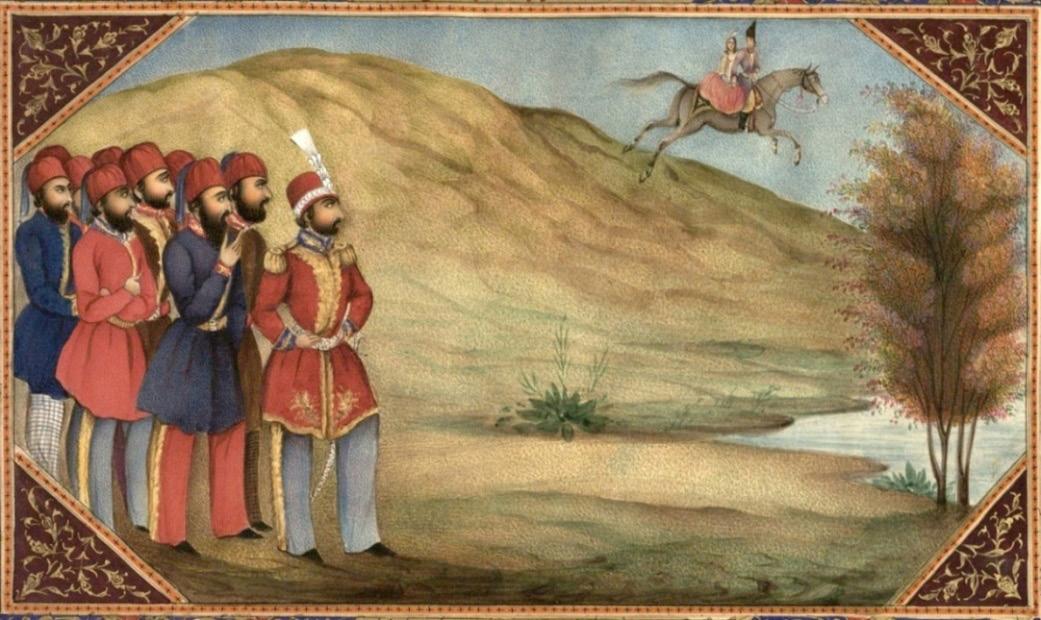
Figure 5. Ebony horse story (1853), Golestan Palace Museum. Source: One Thousand and One Nights, illustrated by Sani ol-Molk
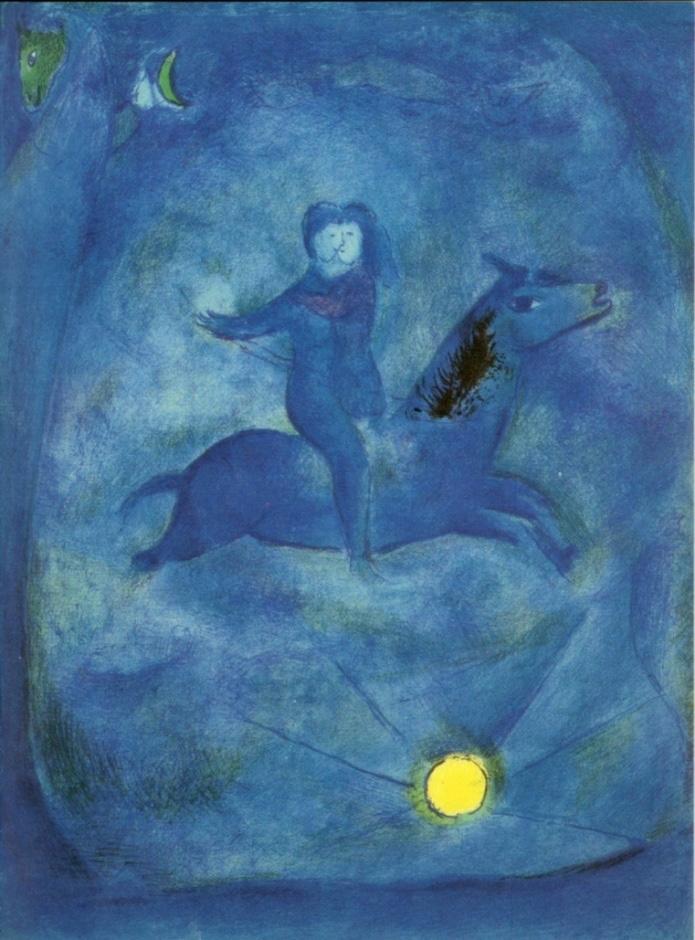
Figure 6. Three hundred and sixty-fourth night, the ebony horse story, One Thousand and One Nights (1948). Source: Arabian Nights by Chagall
It can be said that Chagall liberated his sensory and emotional perceptions in creation, as the page is an arena for his fantasies to star. This, in contrast with the rational composition and Iranian painting-specific colors used in Sani ol-Molk's works. The main difference between Sani ol-Molk's paintings and Chagall's works is the way they represent the plans of the stories. Sani ol-Molk is committed to representing the real world and real people of the Qajar period in his illustrations. He stayed as far from fantasy as possible, apart from some parts of the illustrations that reflect the fictitious atmosphere of the story. Pakbaz (2007) argues that
even trivial efforts have not been made to display a world separated from the tangibility of the material world and the purpose of disconnecting from the real world in which people are accustomed to experience everyday life. Unlike the thematic tradition of Iranian paintings, in which heroes and various events have originated from the depths of history and human beings’ collective memory and have come into exist with the help of archetypes, describing the world beyond time and space. A world full of mysteries, symbols and allegories”. (p. 6)
Fidelity with regard to nature is also seen in Sani ol-Molk's works in in terms of composition, color, and form.
Another work by Sani ol-Molk portrays the story of Abdullah Bahri and Abdullah Bari (Figure 7). Abdullah Bahri, who lives underwater, takes Abdullah Bari, who lives on the earth, to meet his king because he is enthusiastic to see a two-legged human. The characters of this painting are standing side by side in a half face view and harmonious rhythm. The way people have been painted is completely in accordance with traditional Qajar painting. Different characters have been portrayed with similar faces and gestures, using the stereotypical aesthetic principles of that time. There is no difference between the men's faces, but, in some slight details such as hairstyle, beard, and mustache, they look rather similar. It seems that, in drawing the faces, as in other One Thousand and One Nights paintings by Sani ol-Molk, no deliberate attempt has been made to show the inner personality. Similarly, in this painting, red is seen in the characters' costumes.
Chagall illustrated the same scene of Abdullah Bahri and Abdullah Bari’s story in a complete different way (Figure 8). The painter used the entire frame to transfer his concepts and did not limit himself to a certain framework:
images that do not sit next to each other bridge the gaps, and suspended flying figures break any aspect of reality, even gravity. In his paintings, everything takes the shape and quality of a fairytale, and the absence of scale intensifies it. This is the logic behind today's postmodernism that praises Chagall for taking advantage of elements of imagination. (Qarabaghi, 2000, p. 49)
Unlike Sani ol-Molk, Chagall did not need to employ scientific principles such as perspective for his artistic expression; “there are similarities in shape and appearance between elements of One Thousand and One Nights and the visual elements of Chagall's paintings” (Nobis, 1990, p. 6). According to this description, it is not surprising that Chagall's One Thousand and One Nights illustrations are indisputably the flagship of his graphic works. Regarding the resemblance between the fiction of One Thousand and One Nights and Chagall's subjective illustrations, the book provides an opportunity for the artist to materialize his imaginations.
Nobis believes that “illustrations from rich stories of One Thousand and One Nights were the source of inspiration for the artist's later works (Oriental-Mystical Lighting in Ballet)” (Nobis, 1990, p. 6). Predominant colors in this image are green and blue, mixed emotionally, as sometimes they appear green and sometimes blue, and the painting depicts the wavy underwater world. Underwater humans and creatures, along with Chagall's weird subjective forms seen in the other works of the artist, all live together sincerely. Chagall “was significantly influenced by the inner joy and irrationality of Jewish teachings. According to those beliefs, one can be closer to God by cultivating inner joy and awareness” (Farzi Dahaneh, 2009, p. 76). He employed the light and color of Eastern mysticism, combined them with Western elements in order to illustrate the immaterial world of One Thousand and One Nights.
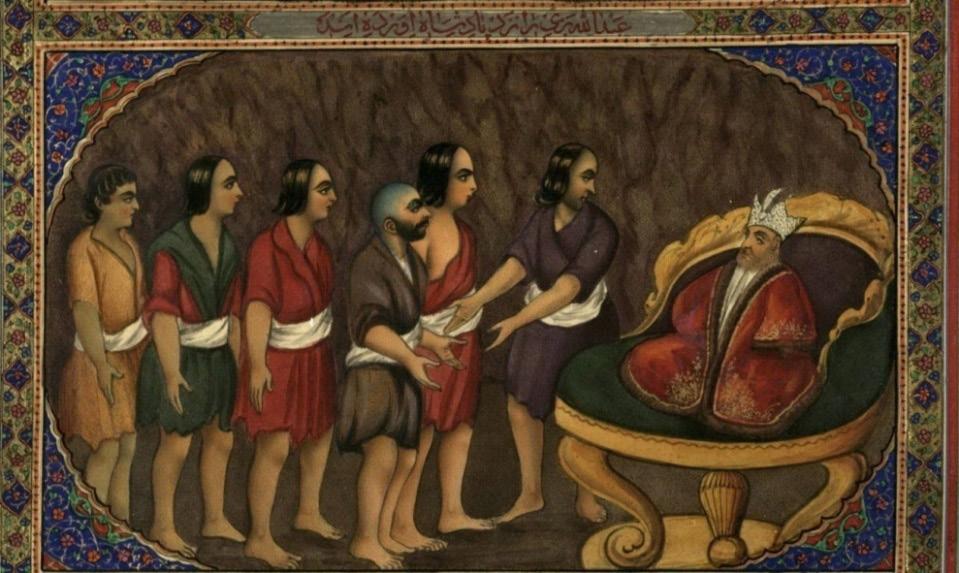
Figure 7. Abdalluh Bahri and Abdalluh Bari (1853), Golestan Palace Museum. Source: One Thousand and One Nights, illustrated by Sani ol-Molk
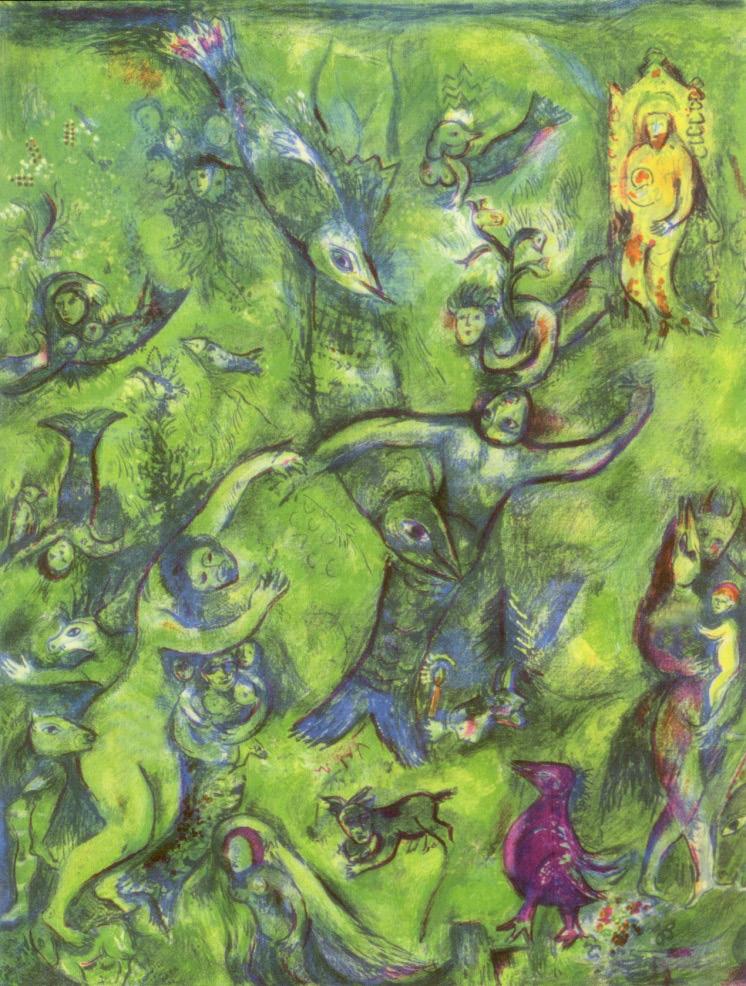
Figure 8. Nine hundred forty-fifth night, One Thousand and One Nights (1948). Source: Arabian Nights by Chagall
Romances
In most stories of One Thousand and One Nights, romance is the predominant theme that shapes the events of the fiction. One of them is Ebony Horse, Badr Bassem and Johare, in which, the ebony horse of the prince comes across Sanaa's daughter. Sani ol-Molk has depicted the scene in a horizontal frame, and he has carefully displayed naturalistic representations of trees, folds of clothes, and faces while trying to observe perspective in painting figures and landscapes under the impression of Western classical art (Figure 9). The horizontal frame’s space has been divided into three vertical sections with a relatively symmetrical composition. In the background, the trees have been painted in a naturalistic way. In the foreground, the male and female characters of the story have been arranged in the order in which they appear in the story, and they all stare into the frame. Sani ol-Molk owed his mastery of making proper composition, arranging visual elements, and choosing the right colors to his well-rounded studies on Iranian painting along with his experiences in Western painting. Sani ol-Molk
paid great attention to the fundamental principles of painting, such as design, structure, composition, space, as well as to having a personal vision. He mastered the relationship between shape and color and knew how to use them to suit the image’s needs. He combined these two synonymous and inseparable elements and created the desired environment. (Buzari, 2004, p. 54)
He (Sani ol-Molk) minimized uniformity and monotony in composition using his own visual tricks. For instance, in Figure 9, the girls and the tree are depicted on the right, and the prince and the daughter of the king of Sanaa are depicted in a vertical line leaning to the left, as they take up more space in the frame. The picture somehow emphasizes that the prince has fallen in love with daughter. The artist
has adapted proportions to the principle of nature as far as he could, observed the accuracy of the plan according to those proportions, and solved the issue of composition regarding the story’s location and theme, sometimes applying Western style and sometimes using Eastern style in completely innovative and self-specific ways. (Zoka, 2003, p. 55)
He has avoided any unrealistic imagination in his works. Chagall, on the other hand, applied blue, purple, and yellow to create an imaginative environment. In Figure 10, the external and internal humor of the characters have been displayed at the same time, and the space frame entirely serves the special visual elements of Chagall. The picture shows the story’s sub-characters while they are asleep in different postures to fit the composition. Chagall seems to have a special interest in depicting romantic atmospheres, which were rooted in his personal life. As we can see, the ebony horse is standing above the prince and the young girl under the moonlight, and it watches them with special love. The painting communicates more feelings and emotions than Sani ol-Molk's illustration, and the painter has achieved a romantic, imaginative atmosphere using a few colors and a large amount of light and dark shades.
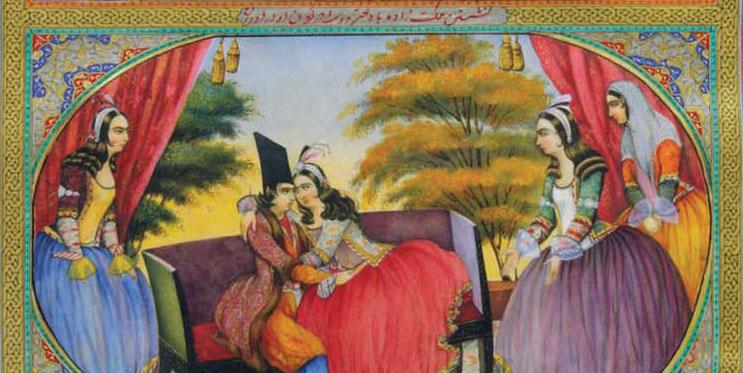
Figure 9. The prince meets the daughter of the king of Sanaa (1853), the ebony horse story, One Thousand and One Nights, Golestan Palace Museum. Source: One Thousand and One Nights, illustrated by Sani ol-Molk
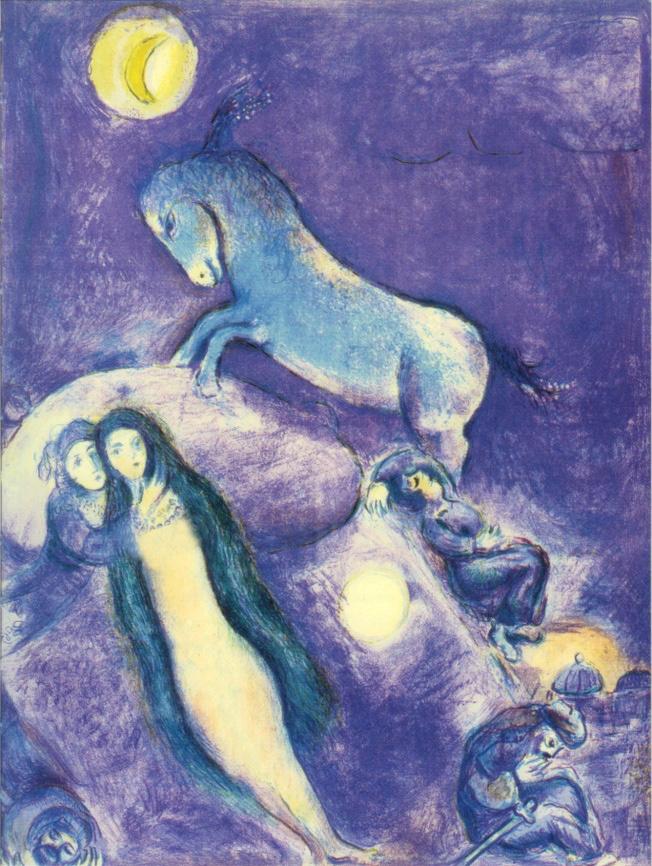
Figure 10. Three hundred and fifty-ninth night, the ebony horse story, One Thousand and One Nights (1948). Source: Arabian Nights by Chagall
Red skirts in women’s costumes and red jacket in those of men are one of the obvious features of Sani ol-Molk’s illustrations. It seems that the painter has used red for the sake of color composition rather than to portray psychological aspects. On the contrary, Chagall's works tend to be more psychological in nature. In another work, Sani ol-Molk, demonstrates his mastery at the naturalistic depicting of grass and trees while combining them with Iranian characters. Figure 11 depicts one of the tales of the One Thousand and One Nights, in which Badrbasem meets Johar for the first time and falls in love with her. According to his elegance at drawing the trees, the painter obviously has an objective, naturalistic view in creating the work. The delicate hatched lines used to add volume to the left-leaning trunk of the tree, the soft light shadows in the meadow, the fading shadows of the trees, and the dark and light masses of leaves show the attention of the painter to depict the naturalistic scene. The red spots behind the dark foliage and their repetition in the trousers and sleeves of Badrbasem show the undeniable genius of the painter in the proper use of colors. The romantic realistic atmosphere –which is fancy at the same time– shines like a jewel amongst Sani ol-Molk's works. The solid composition and complementary colors along with the complementary personalities of men and women create a unique impression in the work.
In Chagall's illustration with the same theme, the arrangement of the same characters is interesting (Figure 12). Johar is on the top, Badrbasem is located at the bottom of the frame, and they are bonded together on the green background of the tree. This work by Chagall seems to illustrate the next plan of Sani ol-Molk's work, which shows the union of the lovers. The sun and the moon, the two usual symbols in Chagall’s works, are stacked together to this effect. Although there are clear structural and technical discrepancies in the painters' illustrations, in this story, both have reached a common point in terms of composition and the use of the same elements with the same color scheme, whose difference lies only in the way they have been applied.
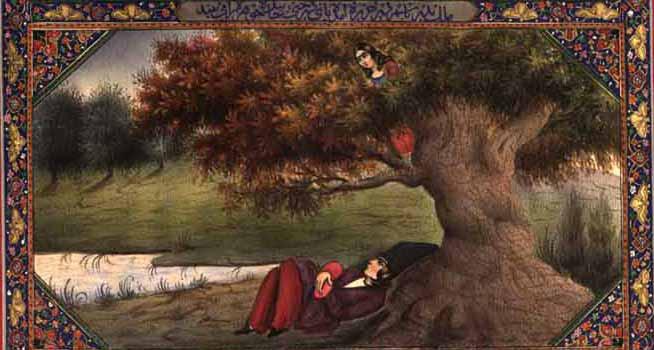
Figure 11. Badrbasem and Johar (1853), One Thousand and One Nights, Golestan Palace Museum. Source: One Thousand and One Nights, illustrated by Sani ol-Molk
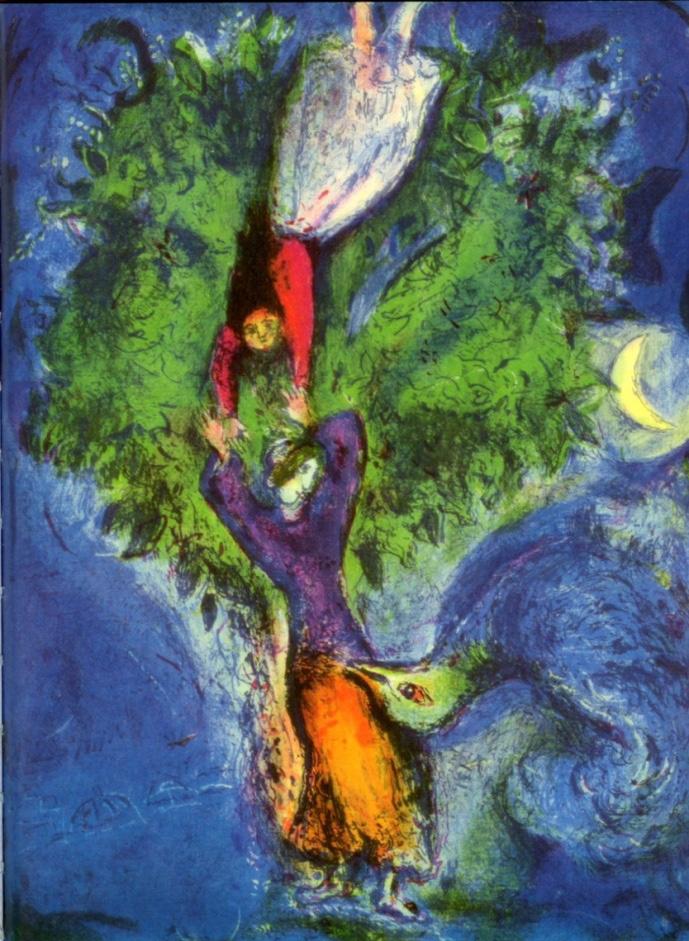
Figure 12. Seven hundred and forty-ninth night, One Thousand and One Nights (1948) Source: Arabian Nights by Chagall
Chagall seems to have more passion for poetry more than his contemporary painters do. Therefore, the relationship between the elements in his works is more emotional than visible;
his paintings do not show the conventional visual images, but they portray parts of reality in a simultaneous way. In his works, suspended and flying figures break any aspect of reality, even gravity; everything takes the shape and quality of a fairytale, and the absence of scale intensifies this. (Gharabaghi, 2000, p. 50)
This imagination that has led to create a fantasy is the common aspect of the illustrations of Chagall and Sani ol-Molk, and it is understood as “the ability to create illustrations from a volatile reality” (Bachelard, 2006, p. 20). In Chagall's works, imagination is a result of improvisation and openly using the domestic elements of his country. In Sani ol-Molk’s works, this stems from applying a combination of the Qajar painting style and Western naturalistic techniques.
Characteristics of Sani ol-Molk’s works
Selecting the prominent Iranian figures for illustrating the story’s characters, implying his tendency to show the Iranian art, traditions, and ordinary lifestyle of the Qajar period, and to provide the audience with close connection to the culture, customs, and traditions of the Qajar Persians, even in fictions.
Using form and color in a way that they suit the image’s needs, as well as applying red for costumes of males and females.
Innovation in narration, as one page includes three to six narrative assemblies separated by gilded margins, and the theme of each assembly is written in Riqa calligraphy and in colorful ink beside it.
Fidelity regarding the visual elements according to the original story.
Use of complementary pairs of colors based on the experience of Iranian painting art.
Similarity of faces, hairstyles, and costumes of males and females, whose personalities are not shown.
Showing people and their limbs in a variety of postures, movements, and angles such as full-face, half-face, and three-quarter-face views –sometimes even from behind.
Masterful combination of Iranian figures and architecture with Western naturalistic atmospheres.
Displaying Qajar architecture in a space often enclosed between two walls, called a triangular corner.
An obvious tendency to be realistic and to avoid any imagination in the limbs and shapes of different people in fairytales.
Characteristics of Chagall’s works
Purposeful use of warm and hot colors to convey the dominant spirit of the story to the audience.
Using dynamic and vertical composition, unlike Sani ol-Molk.
Observing the perspective on authority instead of the scientific perspective in depicting the characters.
Employing color, form, and composition to represent the emotional burden of the story.
Applying a combination of Iranian, Indian, and Arabic elements and oriental lighting integrated with Western visual culture to illustrate the stories.
Omitting the dimensions, time, and place of the stories and displaying several plans in one page.
Ignoring every conventional shape and form to display imaginary forms freely, which seem to be suspended in space.
Ignoring the elements of the main story according to his subjective world, deliberately omitting parts of the story or adding some to it.
Consciously selecting rising and falling actions of the story.
Considerable use of psychological features in form and color along with domestic elements in his works.
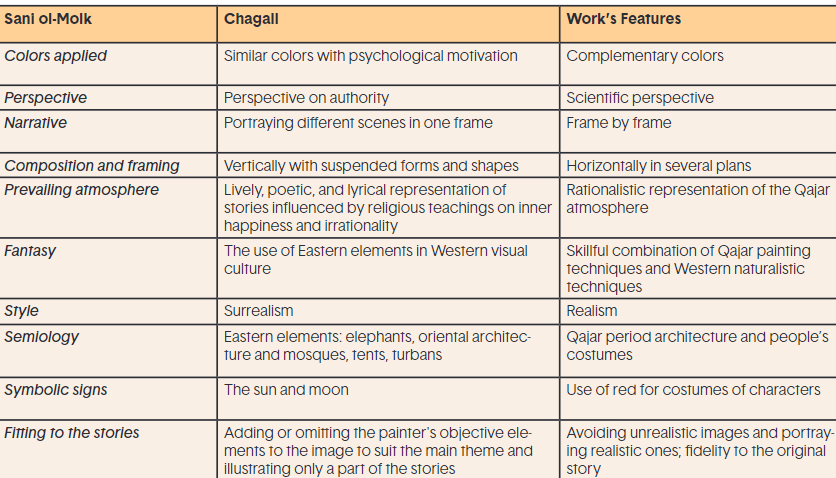
Table 1. Significant structural differences between the illustrations of Sani ol-Molk and Chagall Source: Authors
Conclusion
Sani ol-Molk has concentrated on creating a tangible world according to his perception of the fancy world of the stories, and he has spent his effort and attention on selecting colors, arranging the characters (visual quality), and, more importantly, on realizing the scenes, with the purpose of amazing the audience by means of the similarity of the narrative atmosphere to the illustrated work. He shows his ability in the naturalism of the dominant atmosphere of the stories. The difficulty of his work lies in accurately depicting the tangible details of specific moments. To make a logical connection between the text and image, he has tried to create naturalistic scenes, which have in turn reduced the imaginary aspects of the scene. Chagall, on the other hand, using a combination of Eastern elements and Western visual culture, has achieved fantasy in his illustrations. According to Norbert Nobis, Chagall owes the eastern atmosphere of his works to the oriental mystical lighting of the stage he had designed for a ballet performance before illustrating the book. He was not necessarily influenced by Eastern mysticism and fantasy. Despite the major differences in terms of the methods used by Sani ol-Molk and Chagall to illustrate One Thousand and One Nights tales, and in the presence of cultural and geographical discrepancies, the two painters have reached a convergence in illustrating the romantic scenes of The Ebony Horse, and Badrbasem and Johar’s story in particular, and depicted the scene rather similarly. Both painters, with different perspectives, borrowing each other's art without being directly influenced by each other, have created the same description of a romantic story from One Thousand and One Nights.
Referencias
Afshar Asl, Mehdi, Khosravi, and Mohammad Baqer (1998). Iranian architecture in the Qajar period. Journal of Art and Architecture, 36,129-140.
Bachelard, G. (2006). External and internal dialectics, phenomenology of imagination (Trans.: Amir Maziar). Tehran, Iran: Academy of Arts Publications.
Barr, A. H. (Ed.) (1986). Defining modern art: Selected writings of Alfred H. Barr. New York, NY, USA: Harry N. Abrams Inc.
Blair, M. (2020). The Art of the 1,001 Nights. https://blairmahoney.medium.com/the-art-of-the-1-001-nights-58d4476c3bfa
Bouzari, A. (2004). One Thousand and One Nights: Of the bridge between East and West. Journal of Culture and People, 11-12, 50-60.
Farzi Dehneh Sari, E. (2009). Research on reality and imagination in the works of Mark Chagall [Master’s thesis, University of Tehran].
Gharabaghi, A. A. (2000). Blue cows and red lovers. Golestaneh Magazine, 24, 47-60.
Hoh, A. (2017). A Thousand and One Nights: Arabian story-telling in world literature. https://blogs.loc.gov/international-collections/2017/10/a-thousand-and-one-nights-arabian-story-telling-in-world-literature/
Mazolov, U. (2004). Iranian prototype of Hazaryik Shab-Hezar Afsan. Journal of Culture and People, 11-12, 6-14.
Nobis, N. (1999). Marc Chagall: Arabian Nights. Munich, Germany: Prestel.
Pakbaz, R. (2007). Iranian painting from long ago to today. Tehran, Iran: Zarrin and Simin Publishing.
Pakbaz, R. (2010). Encyclopedia of art (11th ed.). Tehran, Iran: Contemporary Culture.
Sojoodi, F., and Gilani, S. (2011). Visual signs of a Thousand and One Nights, a comparative study of illustrations by Sani ol-Molk and Mark Chagall. Journal of Visual Arts, 2, 42-55.
Zabolinezhad, H., Pencenat, C., and Shad Qazvini, P. (2020). A new ontology study in contemporary art. Journal of Critical Reviews, 9(7), 480-486. https://www.coursehero.com/file/81565290/197-1591270499pdf/
Zarezadeh, F., and Shad Qazvini, P. (2008). A study of realistic codes in the manuscript of Hezarovik Shab. Islamic Art Studies, 9, 50-62.
Zoka, Y. (2003). Life and works of Ostad Sani ol-Molk. Tehran, Iran: University Publishing Center of the Cultural Heritage Organization.
Recibido: 24 de octubre de 2021; Aceptado: 30 de enero de 2022
Resumen
Este artículo estudió los cuadros de Sani ol-Molk, un artista Qajar iraní, y los de Chagall, un artista ruso-judío, y tiene por objetivo responder la pregunta por qué elementos y técnicas utilizaron los artistas para ilustrar historias de Las mil y una noches de tal modo que la forma sirviera apropiadamente al contenido. Los dos pintores, Sani ol-Molk y Chagall, con puntos de vista particulares, influenciados por discrepancias socioculturales de Oriente y Occidente respectivamente, crearon cuadros para las historias utilizando sus propios estilos artísticos. Este artículo comparó pares de ilustraciones de Sani ol-Molk y Chagall que tienen el mismo tema pero son completamente distintos tanto estructural como estéticamente. También analizó las obras en cuanto a la forma, la composición, el color, los elementos visuales y los símbolos. Los pares se dividen entre tres categorías de acuerdo con su tema, lo cual incluye romances, imaginarios, y la vida cotidiana. A pesar de las diferencias considerables entre las obras de los dos pintores, tanto Sani ol-Molk (combinando técnicas naturalísticas y estilos de pintura Qajar) y Chagall (utilizando libremente la cultura visual, los colores y las formas de la cultura visual occidental y mezclándolos con elementos iraníes, indios y árabes, así como con iluminación oriental) ilustraron Las mil y una noches de manera exitosa y lograron crear una fantasía.
Palabras clave
Chagall, ilustración, Las mil y una noches, elementos orientales, Sani ol-Molk.Abstract
This paper studied the paintings of Sani ol-Molk, a Qajar Iranian artist, as well as those of Chagall, a Russian-Jewish artist, and it aims to answer the question of what elements and techniques were employed by the artists to illustrate One Thousand and One Nights stories in such a way that the form appropriately serves the content. The two painters, Sani ol-Molk and Chagall, with distinct viewpoints, influenced by Eastern and Western socio-cultural discrepancies, respectively, created paintings for the stories using their own artistic styles. This paper compared pairs of Sani ol-Molk and Chagall’s illustrations that have the same theme but are completely different both structurally and aesthetically. It also analyzed the works in terms of form, composition, color, visual elements, and symbols. The pairs are divided into three categories in terms of their subject, including romances, imaginaries, and everyday life. Despite the considerable differences between the works of the two painters, both Sani ol-Molk (by combining naturalistic techniques and Qajar painting styles) and Chagall (by freely using Western visual culture, colors, and forms and mixing them with Iranian, Indian, and Arabic elements as well as with oriental lighting) illustrated One Thousand and One Nights successfully and achieved to create a fantasy.
Keywords
Chagall, illustration, One Thousand and One Nights, oriental elements, Sani ol-Molk.Résumé
Cet article a étudié les peintures de Sani ol-Molk , un artiste Qajar iranien , et ceux de Chagall, un artiste juif russe, et vise à répondre à la question de savoir quels éléments et techniques les artistes ont utilisés pour illustrer les histoires des Mille et une Nuits de telle manière que forme ait servi de manière appropriée le contenu. Les deux peintres, Sani Ol-Molk et Chagall, avec des points de vue particuliers, influencés respectivement par les divergences socioculturelles de l'Est et de l'Ouest, ont créé des cadres pour les histoires en utilisant leurs propres styles artistiques. Cet article a comparé des paires d'illustrations de Sani ol-Molk et Chagall qui ont le même thème mais sont complètement différentes à la fois structurellement et esthétiquement. L’on a également analysé les œuvres en termes de forme, de composition, de couleur, d'éléments visuels et de symboles. Les paires sont divisées en trois catégories selon leur thème, qui comprend les liaisons amoureuses, l'imaginaire et la vie quotidienne. Malgré les différences considérables entre les œuvres des deux peintres, Sani ol-Molk (combinant des techniques naturalistes et des styles de peinture Qajar ) aussi bien que Chagall (utilisant librement les couleurs et les formes de la culture visuelle occidentale et les mélangeant avec des éléments iraniens, indiens et arabes ainsi que l'éclairage oriental) ont illustré Les Mille et Une Nuits avec succès et ont réussi à créer une fantaisie.
Mots clés
Chagall, illustration, Mille et une Nuits, éléments orientaux, Sani ol-Molk.Resumo
Este artigo estudou os quadros de Sani ol-Molk, um artista Qatar iraniano, e os de Chagall, um artista russo-judio, e tem por objetivo responder à questão de quais elementos e técnicas os artistas utilizaram para ilustrar histórias de As Mil e Uma Noites de tal modo que a forma serviu apropriadamente ao conteúdo. Os dois pintores, Sani ol-Molk e Chagall, com pontos de vista particulares, influenciados por discrepâncias socioculturais no Oriente e no Ocidente, respectivamente, criaram quadros para as histórias utilizando seus próprios estilos artísticos. Este artigo comparou pares de ilustrações de Sani ol-Molk e Chagall que têm o mesmo tema mas são completamente distintos tanto estrutural como esteticamente. Também analisou as obras enquanto a forma, a composição, a cor, os elementos visuais e os símbolos. Os pares se dividem entre três categorias de acordo com o seu tema, o qual inclui romances, imaginários e a vida cotidiana. Apesar das diferenças consideráveis entre as obras dos dois pintores, tanto Sani ol-Molk (combinando técnicas naturalistas e estilos de pintura Qatar) e Chagall (utilizando livremente a cultura visual, as cores e as formas da cultura visual ocidental e mesclando-as com elementos iranianos, indianos e árabes, assim como iluminação oriental) ilustraram As Mil e Uma Noites com sucesso e conseguiram criar uma fantasia.
Palavras-chave
Chagall, ilustração, As mil e uma noites, elementos orientais, Sani ol-Molk.Introduction
One Thousand and One Nights has been always interesting for artists from various fields of art, and many composers, moviemakers, painters, architects, and writers have chosen it as a rich source of inspiration for their works. The main story is about a Sasanian monarch (Shahryar), an it is narrated by his Minister's daughter (Shahrazad). The story goes that, when Shahryar discovered that his queen was unfaithful, he decided to take revenge. He first killed the queen and then took a new bride each night to have her murdered the next morning over a three-year period. Eventually, the Minister, who was responsible for finding the new brides, could not bear the cruelty of the action and asked his wise daughter, Shahrazad, to find a solution. Shahrazad volunteered to marry Shahryar and began telling him a collection of stories, but she would halt her story at a suspenseful moment and tell Shahryar that she would finish it the following night if he let her to live one more night. This happened for 1,001 nights consecutive. On the last night, the king, who had fallen in love with Shahrazad, relinquished murdering her, and they lived together peacefully for the rest of their lives. Most of the adventures of One Thousand and One Nights take place in Baghdad. However, some stories have Iranian origin and were influenced by Indian or Arabic works: As it [was] mentioned before, the tales themselves combine many genres, and draw from the very rich heritage and folkloric tradition of the entire Middle Eastern region. They combine the magical, the mystical, and the mythical, with the real and the historical. Some of the main protagonists in the tales, for example, are the famous Abbasid Caliph Harun al-Rashid and his Grand Vizier Ja’far Barmaki, as well as the famous poet Abu al-Nuwwas, in addition to genies, ghouls, and mythical giant birds such as the Ruk. It is worth noting, however, that due to the folkloric nature of the tales, the Arabian Nights were often considered plebian rather than high literature. Furthermore, because some of the stories contain explicit sexuality and sexual innuendo, as well as bawdy language, and themes not acceptable by polite society, they were also deemed quite vulgar. (Hoh, 2017)
No one knows the exact age of the stories. Although the collection of stories is read and understood by the cultures that have affected it for centuries, it should be noted that it does not communicate concepts such as originality, style, or individual and ethnic identity. Nesting storytelling is the narrative structure of One Thousand and One Nights, as often more than two nested stories are narrated in parallel. The book One Thousand and One Nights, by Sania ol-Molk, is one of the most detailed illustrations adapted from a literary work. In his illustrations, Sania ol-Molk depicted various aspects of the everyday and private life of ordinary people who lived in the Qajar period (1789-1925) in Iran, as shown in scenes such as bathing, cooking, eating, horseback riding, dancing, sleeping, etc. Furthermore, the painter has not refrained from illustrating the scenes that were not considered to be worthy of displaying until then. He explicitly depicted social behaviors such as violence and reconciliation, fighting, kicking, conspiracy, and so on. Therefore, in his works, there are variety of body gestures according to the themes of the stories: that is why we subscribe entirely to the point of view of Ernest Gombrich and Nelson Good Man concerning a pictorial representation which would move towards the establishment of a conception on the perception of images. This conception follows conventions internalized by the person who perceives them, conventions that differ from each other and each one of us establishes them according to our own way of life, so we can link the exercise of Segall, Campbell, and Herskowitz with Gombrich and GoodMan's hypothesis concerning the conventional codes governing the perception of images. (Zabolinezhad, Pencenat, and Shad Qazvini, 2020, p. 942) During the eighth century, many Persian stories were translated into Arabic. According to professor Ulrich Marzolph (1953), “there are striking similarities between One Thousand and One Nights tales and the Torah stories, especially in the book of Esther” (Marzolph, 2004, p. 8).
Perhaps this was the main reason for Chagall to take up illustrating One Thousand and One Nights stories, as he had previously illustrated 63 pages of the Bible. His style with regard to painting characters in his works was in accordance with the mystical teachings of Russian Judaism, which were interpreted with the painter's mystical viewpoint. He is among a few artists who used Eastern elements to successfully translate the stories into images, so that they were understandable to Western people. Some questions arise here: How was a combination of Eastern elements and Western naturalistic techniques able to create fantasy in the works of Sani ol-Molk and Chagall? How does the painters' illustrations reflect the narrative features of the stories? Can a common ground between the exorbitant dissimilarities of the painters' works be found? This study aims to determine the artistic features and different aspects of Sani ol-Molk and Chagall's works which were adopted for stories with the same theme. It also attempts to provide a comparative analysis based on the structural differentiations between the illustrations of the above-mentioned painters.
Library research
There are studies that compare the illustrated works of Sani ol-Molkand and Chagall from One Thousand and One Nights, such as Visual Semiotics of One Thousand and One Nights. A Comparative Study of Illustrated Works of Sani ol-Molk and Marc Chagall by Farzan Sojoodi and Saedeh Gilani (2011). The paper studies how the works of said authors were influenced by their geography, culture, and society, and it concludes that culture and art represent social realities. Fahimeh Zarezadeh and Parisa Shad Qazvini (2008), in another paper titled The Analysis of Realistic Codes in The Manuscript of One Thousand and One Nights, state a number of facts about the relationship between human beings and the environment and then conclude that Sani ol-Molk has reflected his cultural values and believes in his illustrations. None of the aforementioned papers performs a comparative aesthetic analysis of the illustrations by Sani ol-Molk and Chagall. Elahe Farzi Dahaneh Seri (2009), in her MA thesis titled A Study of Reality and Fantasy in the Works of Marc Chagall attempted to define fantasy, reality, and their connection in Chagall's paintings.
Methodology
This study used a descriptive-analytical-comparative method based on an aesthetic approach, and its information resource of the study consisted of library studies and scientific research articles.
Everyday life
Some tales of One Thousand and One Nights take place on the streets and represent everyday life, and Sani ol-Molk depicted scenes of everyday life in the Qajar period to illustrate them. He was quite skillful in showing the interior spaces and corners of buildings and mansions of the Qajar time (Figure 1). Figure 1 shows parts of Qamar ol-Zaman's father aristocratic house, with walls embellished by colorful murals. The painting shows Gohari, admiring the beauty of Qamar ol-Zaman because she reminds him of his lover. The naturalistic display of the trees behind the window, applying western style and combining it with the interior space using the Iranian painting style has been skillfully performed, in such a way that the differences of the applied styles are hardly noticeable: he has adapted proportions to the principle of nature as much as possible, observed the accuracy of the plan according to those proportions, and made a composition regarding the location and the theme, by incorporating Eastern and western styles in a completely innovative and specific way. (Zoka, 2003, p. 34)
While creating his illustrations, Sani ol-Molk was inspired by the lives of the Iranian people during the 13th century AH. Therefore, his illustrations from One Thousand and One Nights depict the clothing of people in Qajar era. Moreover, from an architectural point of view, in Sani-ol-Molk's illustrations, one can see houses, rooms, niches, walls, sash windows and French-style windows that had just arrived in Iran, paving yards, pools, kitchens, treasury baths, bazaars, and many other architectural features of the Qajar era. (Zoka, 2003, p. 34) These are among the architectural visual documents of Qajar period, and, in contrast to the tradition of Iranian painting, which often shows an architectural structure as a whole, they reflect part of a certain structure, which is chosen based on the logic of narration, regardless of emphasizing on aesthetic quality. In order to display the events that happened in the buildings, Sani ol-Molk often chooses the spaces enclosed between two interior walls called triangular corners.
Figure 1. Qamar Al-Zaman and Gohari story (1853), Sani ol-Molk, Golestan Palace Museum. Source: One Thousand and One Nights, illustrated by Sani ol-Molk
Figure 2. Nine hundred and sixty-fifth night, from One Thousand and One Nights (1948), Chagall. Source: Arabian Nights by Chagall According to Asl, Khosravi, and Baqer,
the architecture of the Qajar dynasty is superior and more complicated than those of former dynasties like Zandieh and Safavid, because diversity and innovation of created spaces increased during the late Qajar era, and old patterns of Iranian architecture evolved in favor of expanding the space. (1998, p. 133)
Therefore, in Sani ol-Molk's paintings, the tendency to open the interior space, to deepen it and turn it into a natural place for living, was influenced by the architectural reforms that took place in Qajar era. Sani ol-Molk achieved a certain narrative style by illustrating different scenes of a story in consecutive frames. Three to six narrative assemblies were illustrated on one page, separated by gilded margins, and the subject of each was written in Riqa calligraphy and in colorful ink on the margin. The narrative aspect of Chagall's works, on the other hand, was characterized by using far and near elements in the same frame on a page. In Figure 2, he depicts subjective and objective spaces together and displays Qamar ol-Zaman and the lover, Darvish, lying on a leaf in the background. Chagall has given Qamar ol-Zaman a female body. In this collection of works, colors and forms are intertwined with the romantic atmosphere of the story, and each section refers to one part of it. In other words, in Chagall's illustrations, time and place disappear, and different scenes are displayed on the same page. Since Chagall emphasizes the psychology of colors in his works, it seems that the red color of Darvish's clothes signifies his great love for Qamar ol-Zaman: “colors in Chagall's works are fluid and free and serve as symbols in his works” (Farzi Dahaneh Seri, 2009, p. 111). Simultaneously displaying the moon and the sun in this work, the yellow and red colors of the background and foreground, the turban on the head of the Qamar standing naked, and a yellow triangular form with fringe, which seems like a desert tent, all arise feeling of hot summer days and oriental features. According to Blair (2020). “in the early 20th century, artists experimented with color and less realistic dimensions, and mixed the worlds of Eastern and Western mythologies.” An interesting point about the elements of the composition is the use of obscured Islamic monuments on both sides of the image. Chagall, by mixing Eastern elements with Western visual culture (the naked woman), has taken the initiative and managed to easily attract the minds of Western audiences; “Chagall, with his dreamy outlook, has given his paintings symbolic meanings by employing religious symbols” (Sojoodi and Gilani, 2011, p. 46).
In another illustration of One Thousand and One Nights by Sani ol-Molk, a woman strolls leisurely along with her servant girls and companions along the streets of Basra on a Friday morning. This panting (Figure 3) shows the horizontal composition of female characters, standing in a harmonious way in full face, half face, and tree-quarter face views, as well as wearing Qajar customs. Qamar ol-Zaman and Gohari are among the stories in which women play a pivotal role. In cultural studies about women, One Thousand and One Nights has been a relatively important reference because it contains dozens of female characters who have various major functional and moral roles:
the book seems to be the result of public opinion and different experiences of its authors […] and has provided the opportunity of expressing an idea, or the way it should be dealt with, and finally, has determined the eternity or mortality of the idea. (Zarezadeh and Shad Qazvini, 2008, p. 55)
In One Thousand and One Nights,Shahrazad describes the women of the stories as persons who are wise, brave, and valiant, professional lovers as well as artists. Consequently, women are not looked down upon by others or made less than what they are. Sani ol-Molk, in line with the narrator of the stories, has provided a neutral image of the women in his works, indicating that he was profoundly influenced by the character of Shahrazad and the other women in the stories.
Figure 3. Qamar ol-Zaman and Gohari story (1853), One Thousand and One Nights, Golestan Palace Museum. Source: One Thousand and One Nights, illustrated by Sani ol-Molk
Figure 4. Nine hundred sixty-sixth night, One Thousand and One Nights (1948), Chagall. Source: Arabian Nights by Chagall
In Sani Al-Molk‘s paintings, women's costumes and their hair, faces, bodies, and makeups are very similar. They have been painted with linked eyebrows, small mouths, and red cheekbones, while a scarf covers half of their black hair. The psychological characteristics and positive and negative personalities of women have been not reflected in their appearances. Accordingly, women's faces are not distinguishable from each other. As it is common in his previous works, red has been used for women’s skirts and upper garments. The background is a simple brick-made texture that does not inspire any dimension or depth to the audience. In contrast to this relatively simple and horizontal composition of Sani ol-Molk, in the composition of Chagall’s work for the same theme, we can see a vertical image with groups of men and women. In Figure 4, red, orange, and purple in the background fit the theme of the story, and oriental architecture is seen in the background of the dancer while the hot and scorching sun, together with warm colors, creates the atmosphere of the painting. Chagall, by adding hot desert colors and Arabic visual elements to the main character of the illustration, who is holding a cloth, has given the story an Arabic identity to some extent. In this scene, Qamar ol-Zaman and her companions stroll leisurely in the alley and bazaar while men are not allowed to enter the alleys until they leave the place. In fact, there is no man in this part of the story. According to Zabolinezhad et al.,
these pictorial representation codes are known to Iranian and even oriental audience. Because these conventional codes are still in force in their traditions of pictorial perception. However, it is quite different for westerners who are not familiar with these codes, and who have no idea how they should receive and interpret these enigmatic scenes. (2020, p. 943)
Chagall, however, has added or omitted a part or some parts to the main image according to his own subjective view and disregarded the main elements of the story. Furthermore, he has depicted the main character as if he were larger than the others, and, unconsciously, he has taken advantage of perspectives on authority in his work. The moon and the sun are constant symbolic elements in Chagall’s works. At the bottom of the frame, Qamar ol-Zaman enters the image from the right while holding a stick in her hand and runs to the left of the frame, inspiring energy and mobility, which are prominent features of Chagall's paintings (Figure 4).
According to Barr, “Russian Jews seem to have had a vibrant and unique culture” (1986, p. 125). It can be said that Chagall's childhood experiences and religious teachings play a major role in his works, which he represents by applying bright and energetic colors. Vertical composition, mobility and dynamicity, warm and energetic colors, the use of oriental and pictorial elements, and the lack of fidelity to the main atmosphere of the story are dominant features of his illustrations, in contrast to the realistic paintings of Sani ol-Molk.
Imaginaries
There are many fairy tales and mythical creatures in One Thousand and One Nights, which provides a good basis for the artists to show their art. In a scene of the ebony horse story with an imaginative theme, Sani ol-Molk has used the main features of Iranian painting to illustrate the fiction. In this painting (Figure 5), the prince kidnaps the daughter of the king of Sanaa and rides to her father's palace. Adding figures on the left and displaying the horse along with two riders on the top right of the frame perfectly creates an Iranian atmosphere. A kind of depth is inspired by displaying pale mountains at the farthest point, and sometimes by drawing minimized trees, buildings, or some other elements in the depth of the image. We can see azure red and blue used in the clothes and pants of the figures. Sani ol-Molk's creativity in combining real and imaginary spaces demonstrates his perfect visual literacy. In fact, Sani ol-Molk's trip to Europe, where he concentrated on real life and taking ordinary people and events as models, significantly influenced his illustrations of of One Thousand and One Nights stories. He portrays people he sees in the Nasserite court (1831-1896), in alleys, and among friends and acquaintances. If he presents a picture of a castle, it is undisputedly an image of a king's palace, and, if he displays a street, he depicts an alley of Tehran in the Nasserite time. According to Barr (1986, p. 120): “the characters of One Thousand and One Nights stories are the people of thirteenth-century Iran, and the stories take place in the Nasserite era”. It can be said that the visual features of Sani ol-Molk's works were considerably influenced by the social atmosphere of his time. Sojoodi and Gilani (2011) state that “one of the most important results obtained from the study of Sani ol-Molk's illustrations is his cultural interpretation, which means that his visual perception of the verbal text was in accordance with the culture of his time” (p. 45). Chagall has created the same scene by applying limited colors in an imaginative atmosphere. Surprisingly, in Figure 6, the horse's head is on the top left corner of the frame and the moon and sun are seen on the top and bottom of the image, respectively. The visual elements have been displayed in pairs, doubling the romantic atmosphere of the work. Black and yellow are the darkest and lightest colors in the illustration, and the different shades of blue, which prevail in the work, are well adjusted next to them. Chagall
wants to show his subjective romantic couple in harmony with Western European lyric poetry. He seems to have had more passion about poetry than his contemporary painters had. As a result, the connection between the elements of his scenes is more emotional than visual. (Gharabaghi, 2000, p. 79)
In the work, colors, forms, and composition all serve emotional expression as much as possible. As Chagall himself admits, he has tried to avoid any conventional shape and form in his work in order to demonstrate rationality and irrationality at the same time. He wishes to create compositions that have a psychological dimension. In a conversation, Chagall stated:
I consider the image as a place for representing objects, people, daemons and birds that have been gathered in chaos to which logic has no way. I think, visual effects are of prime importance, and anything else that is involved in the structure of the image is considered secondary. (Gharabaghi, 2000, p. 48)
Figure 5. Ebony horse story (1853), Golestan Palace Museum. Source: One Thousand and One Nights, illustrated by Sani ol-Molk
Figure 6. Three hundred and sixty-fourth night, the ebony horse story, One Thousand and One Nights (1948). Source: Arabian Nights by Chagall
It can be said that Chagall liberated his sensory and emotional perceptions in creation, as the page is an arena for his fantasies to star. This, in contrast with the rational composition and Iranian painting-specific colors used in Sani ol-Molk's works. The main difference between Sani ol-Molk's paintings and Chagall's works is the way they represent the plans of the stories. Sani ol-Molk is committed to representing the real world and real people of the Qajar period in his illustrations. He stayed as far from fantasy as possible, apart from some parts of the illustrations that reflect the fictitious atmosphere of the story. Pakbaz (2007) argues that
even trivial efforts have not been made to display a world separated from the tangibility of the material world and the purpose of disconnecting from the real world in which people are accustomed to experience everyday life. Unlike the thematic tradition of Iranian paintings, in which heroes and various events have originated from the depths of history and human beings’ collective memory and have come into exist with the help of archetypes, describing the world beyond time and space. A world full of mysteries, symbols and allegories”. (p. 6)
Fidelity with regard to nature is also seen in Sani ol-Molk's works in in terms of composition, color, and form.
Another work by Sani ol-Molk portrays the story of Abdullah Bahri and Abdullah Bari (Figure 7). Abdullah Bahri, who lives underwater, takes Abdullah Bari, who lives on the earth, to meet his king because he is enthusiastic to see a two-legged human. The characters of this painting are standing side by side in a half face view and harmonious rhythm. The way people have been painted is completely in accordance with traditional Qajar painting. Different characters have been portrayed with similar faces and gestures, using the stereotypical aesthetic principles of that time. There is no difference between the men's faces, but, in some slight details such as hairstyle, beard, and mustache, they look rather similar. It seems that, in drawing the faces, as in other One Thousand and One Nights paintings by Sani ol-Molk, no deliberate attempt has been made to show the inner personality. Similarly, in this painting, red is seen in the characters' costumes.
Chagall illustrated the same scene of Abdullah Bahri and Abdullah Bari’s story in a complete different way (Figure 8). The painter used the entire frame to transfer his concepts and did not limit himself to a certain framework:
images that do not sit next to each other bridge the gaps, and suspended flying figures break any aspect of reality, even gravity. In his paintings, everything takes the shape and quality of a fairytale, and the absence of scale intensifies it. This is the logic behind today's postmodernism that praises Chagall for taking advantage of elements of imagination. (Qarabaghi, 2000, p. 49)
Unlike Sani ol-Molk, Chagall did not need to employ scientific principles such as perspective for his artistic expression; “there are similarities in shape and appearance between elements of One Thousand and One Nights and the visual elements of Chagall's paintings” (Nobis, 1990, p. 6). According to this description, it is not surprising that Chagall's One Thousand and One Nights illustrations are indisputably the flagship of his graphic works. Regarding the resemblance between the fiction of One Thousand and One Nights and Chagall's subjective illustrations, the book provides an opportunity for the artist to materialize his imaginations.
Nobis believes that “illustrations from rich stories of One Thousand and One Nights were the source of inspiration for the artist's later works (Oriental-Mystical Lighting in Ballet)” (Nobis, 1990, p. 6). Predominant colors in this image are green and blue, mixed emotionally, as sometimes they appear green and sometimes blue, and the painting depicts the wavy underwater world. Underwater humans and creatures, along with Chagall's weird subjective forms seen in the other works of the artist, all live together sincerely. Chagall “was significantly influenced by the inner joy and irrationality of Jewish teachings. According to those beliefs, one can be closer to God by cultivating inner joy and awareness” (Farzi Dahaneh, 2009, p. 76). He employed the light and color of Eastern mysticism, combined them with Western elements in order to illustrate the immaterial world of One Thousand and One Nights.
Figure 7. Abdalluh Bahri and Abdalluh Bari (1853), Golestan Palace Museum. Source: One Thousand and One Nights, illustrated by Sani ol-Molk
Figure 8. Nine hundred forty-fifth night, One Thousand and One Nights (1948). Source: Arabian Nights by Chagall
Romances
In most stories of One Thousand and One Nights, romance is the predominant theme that shapes the events of the fiction. One of them is Ebony Horse, Badr Bassem and Johare, in which, the ebony horse of the prince comes across Sanaa's daughter. Sani ol-Molk has depicted the scene in a horizontal frame, and he has carefully displayed naturalistic representations of trees, folds of clothes, and faces while trying to observe perspective in painting figures and landscapes under the impression of Western classical art (Figure 9). The horizontal frame’s space has been divided into three vertical sections with a relatively symmetrical composition. In the background, the trees have been painted in a naturalistic way. In the foreground, the male and female characters of the story have been arranged in the order in which they appear in the story, and they all stare into the frame. Sani ol-Molk owed his mastery of making proper composition, arranging visual elements, and choosing the right colors to his well-rounded studies on Iranian painting along with his experiences in Western painting. Sani ol-Molk
paid great attention to the fundamental principles of painting, such as design, structure, composition, space, as well as to having a personal vision. He mastered the relationship between shape and color and knew how to use them to suit the image’s needs. He combined these two synonymous and inseparable elements and created the desired environment. (Buzari, 2004, p. 54)
He (Sani ol-Molk) minimized uniformity and monotony in composition using his own visual tricks. For instance, in Figure 9, the girls and the tree are depicted on the right, and the prince and the daughter of the king of Sanaa are depicted in a vertical line leaning to the left, as they take up more space in the frame. The picture somehow emphasizes that the prince has fallen in love with daughter. The artist
has adapted proportions to the principle of nature as far as he could, observed the accuracy of the plan according to those proportions, and solved the issue of composition regarding the story’s location and theme, sometimes applying Western style and sometimes using Eastern style in completely innovative and self-specific ways. (Zoka, 2003, p. 55)
He has avoided any unrealistic imagination in his works. Chagall, on the other hand, applied blue, purple, and yellow to create an imaginative environment. In Figure 10, the external and internal humor of the characters have been displayed at the same time, and the space frame entirely serves the special visual elements of Chagall. The picture shows the story’s sub-characters while they are asleep in different postures to fit the composition. Chagall seems to have a special interest in depicting romantic atmospheres, which were rooted in his personal life. As we can see, the ebony horse is standing above the prince and the young girl under the moonlight, and it watches them with special love. The painting communicates more feelings and emotions than Sani ol-Molk's illustration, and the painter has achieved a romantic, imaginative atmosphere using a few colors and a large amount of light and dark shades.
Figure 9. The prince meets the daughter of the king of Sanaa (1853), the ebony horse story, One Thousand and One Nights, Golestan Palace Museum. Source: One Thousand and One Nights, illustrated by Sani ol-Molk
Figure 10. Three hundred and fifty-ninth night, the ebony horse story, One Thousand and One Nights (1948). Source: Arabian Nights by Chagall
Red skirts in women’s costumes and red jacket in those of men are one of the obvious features of Sani ol-Molk’s illustrations. It seems that the painter has used red for the sake of color composition rather than to portray psychological aspects. On the contrary, Chagall's works tend to be more psychological in nature. In another work, Sani ol-Molk, demonstrates his mastery at the naturalistic depicting of grass and trees while combining them with Iranian characters. Figure 11 depicts one of the tales of the One Thousand and One Nights, in which Badrbasem meets Johar for the first time and falls in love with her. According to his elegance at drawing the trees, the painter obviously has an objective, naturalistic view in creating the work. The delicate hatched lines used to add volume to the left-leaning trunk of the tree, the soft light shadows in the meadow, the fading shadows of the trees, and the dark and light masses of leaves show the attention of the painter to depict the naturalistic scene. The red spots behind the dark foliage and their repetition in the trousers and sleeves of Badrbasem show the undeniable genius of the painter in the proper use of colors. The romantic realistic atmosphere –which is fancy at the same time– shines like a jewel amongst Sani ol-Molk's works. The solid composition and complementary colors along with the complementary personalities of men and women create a unique impression in the work.
In Chagall's illustration with the same theme, the arrangement of the same characters is interesting (Figure 12). Johar is on the top, Badrbasem is located at the bottom of the frame, and they are bonded together on the green background of the tree. This work by Chagall seems to illustrate the next plan of Sani ol-Molk's work, which shows the union of the lovers. The sun and the moon, the two usual symbols in Chagall’s works, are stacked together to this effect. Although there are clear structural and technical discrepancies in the painters' illustrations, in this story, both have reached a common point in terms of composition and the use of the same elements with the same color scheme, whose difference lies only in the way they have been applied.
Figure 11. Badrbasem and Johar (1853), One Thousand and One Nights, Golestan Palace Museum. Source: One Thousand and One Nights, illustrated by Sani ol-Molk
Figure 12. Seven hundred and forty-ninth night, One Thousand and One Nights (1948) Source: Arabian Nights by Chagall
Chagall seems to have more passion for poetry more than his contemporary painters do. Therefore, the relationship between the elements in his works is more emotional than visible;
his paintings do not show the conventional visual images, but they portray parts of reality in a simultaneous way. In his works, suspended and flying figures break any aspect of reality, even gravity; everything takes the shape and quality of a fairytale, and the absence of scale intensifies this. (Gharabaghi, 2000, p. 50)
This imagination that has led to create a fantasy is the common aspect of the illustrations of Chagall and Sani ol-Molk, and it is understood as “the ability to create illustrations from a volatile reality” (Bachelard, 2006, p. 20). In Chagall's works, imagination is a result of improvisation and openly using the domestic elements of his country. In Sani ol-Molk’s works, this stems from applying a combination of the Qajar painting style and Western naturalistic techniques.
Characteristics of Sani ol-Molk’s works
Selecting the prominent Iranian figures for illustrating the story’s characters, implying his tendency to show the Iranian art, traditions, and ordinary lifestyle of the Qajar period, and to provide the audience with close connection to the culture, customs, and traditions of the Qajar Persians, even in fictions.
Using form and color in a way that they suit the image’s needs, as well as applying red for costumes of males and females.
Innovation in narration, as one page includes three to six narrative assemblies separated by gilded margins, and the theme of each assembly is written in Riqa calligraphy and in colorful ink beside it.
Fidelity regarding the visual elements according to the original story.
Use of complementary pairs of colors based on the experience of Iranian painting art.
Similarity of faces, hairstyles, and costumes of males and females, whose personalities are not shown.
Showing people and their limbs in a variety of postures, movements, and angles such as full-face, half-face, and three-quarter-face views –sometimes even from behind.
Masterful combination of Iranian figures and architecture with Western naturalistic atmospheres.
Displaying Qajar architecture in a space often enclosed between two walls, called a triangular corner.
An obvious tendency to be realistic and to avoid any imagination in the limbs and shapes of different people in fairytales.
Characteristics of Chagall’s works
Purposeful use of warm and hot colors to convey the dominant spirit of the story to the audience.
Using dynamic and vertical composition, unlike Sani ol-Molk.
Observing the perspective on authority instead of the scientific perspective in depicting the characters.
Employing color, form, and composition to represent the emotional burden of the story.
Applying a combination of Iranian, Indian, and Arabic elements and oriental lighting integrated with Western visual culture to illustrate the stories.
Omitting the dimensions, time, and place of the stories and displaying several plans in one page.
Ignoring every conventional shape and form to display imaginary forms freely, which seem to be suspended in space.
Ignoring the elements of the main story according to his subjective world, deliberately omitting parts of the story or adding some to it.
Consciously selecting rising and falling actions of the story.
Considerable use of psychological features in form and color along with domestic elements in his works.
Table 1. Significant structural differences between the illustrations of Sani ol-Molk and Chagall Source: Authors
Conclusion
Sani ol-Molk has concentrated on creating a tangible world according to his perception of the fancy world of the stories, and he has spent his effort and attention on selecting colors, arranging the characters (visual quality), and, more importantly, on realizing the scenes, with the purpose of amazing the audience by means of the similarity of the narrative atmosphere to the illustrated work. He shows his ability in the naturalism of the dominant atmosphere of the stories. The difficulty of his work lies in accurately depicting the tangible details of specific moments. To make a logical connection between the text and image, he has tried to create naturalistic scenes, which have in turn reduced the imaginary aspects of the scene. Chagall, on the other hand, using a combination of Eastern elements and Western visual culture, has achieved fantasy in his illustrations. According to Norbert Nobis, Chagall owes the eastern atmosphere of his works to the oriental mystical lighting of the stage he had designed for a ballet performance before illustrating the book. He was not necessarily influenced by Eastern mysticism and fantasy. Despite the major differences in terms of the methods used by Sani ol-Molk and Chagall to illustrate One Thousand and One Nights tales, and in the presence of cultural and geographical discrepancies, the two painters have reached a convergence in illustrating the romantic scenes of The Ebony Horse, and Badrbasem and Johar’s story in particular, and depicted the scene rather similarly. Both painters, with different perspectives, borrowing each other's art without being directly influenced by each other, have created the same description of a romantic story from One Thousand and One Nights.
Referencias
License
Copyright (c) 2022 Adham Zargham, Leyla Sharifi, Hoda Zabolinezhad

This work is licensed under a Creative Commons Attribution-NonCommercial-ShareAlike 4.0 International License.
Licencia actual vigente
Creative Commons BY NC SA - Atribución – No comercial – Compartir igual. Vigente a partir del Vol. 17 No. 32: (julio-diciembre) de 2022.
This work is licensed under a https://creativecommons.org/licenses/by-nc-sa/4.0/deed.es
Licencias anteriores
- Desde el Vol. 14 Núm. 25 (2019) hasta el Vol. 17 Núm. 31: enero-junio de 2022 se utilizó la licencia Creative Commons BY NC ND https://creativecommons.org/licenses/by-nc-nd/4.0/deed.es
- Desde el Vol 1 Num 1 (2007) hasta el Vol. 13 Núm. 23 (2018) la licencia fue Creative Commons fue Reconocimiento- Nocomercial-Sin obras derivadas 2.5 Colombia https://creativecommons.org/licenses/by/2.5/co/

























